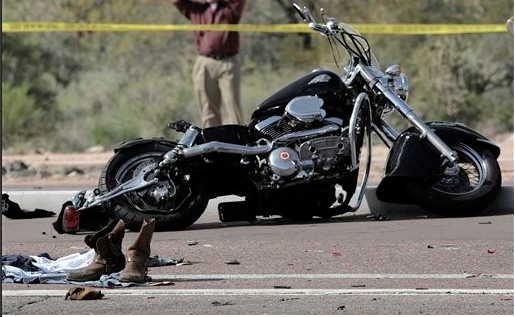As a former experienced Emergency Room Trauma Nurse, Marjorie Chalfant has seen motorcycle victims injured and killed firsthand…AND IN MOST CASES THE BIKER WASN’T AT FAULT!
Motorcycle accidents are most frequent when the biker is:
At an intersection;
- In front of a car that didn’t stop at an intersection or traffic light (hit from behind);
- Cut off by a car pulling out in front of them onto the highway (vehicles failing to yield);
- Traveling with the right-of-way at an intersection when a car makes a left-hand turn into the biker’s lane; and
- Hit by a vehicle making a lane (especially in blind spots)
Most often, the driver doesn’t see the motorcycle or misjudges its speed and/or distance. Car drivers frequently exclaim, “I didn’t see the motorcycle!” “It came out of nowhere!”
While 20% of all automobile crashes result in injuries or death, approximately 80% of all bikers are seriously injured or killed when a motorcycle is involved. Contact The Nurse Attorney, PLLC motorcycle accident attorney today, and get help!
FLORIDA MOTORCYCLE ACCIDENTS FAQ
What Car Drivers Can Do to Help Bikers?
Improve awareness of motorcycles: Look for motorcycles…then look again. Look twice at intersections, especially when turning left (the most common crash problem). Be aware of motorcycles around you (in front, behind and in nearby lanes). Look for riders before pulling out onto the road. Because of their smaller size, motorcycles are often overlooked or not noticed by automobile drivers.
Respect motorcyclists’ rights: Motorcycles have all the privileges of any vehicle on the road. Give motorcycles the same space you’d give any other vehicle – a full lane. Although a motorcycle takes up less space in the lane, a rider needs more room to maneuver safely.
Anticipate a motorcyclist’s maneuvers: Motorcyclists may change lane positions in response to road conditions, weather or other factors. Small objects in the road, potholes, wet leaves, or other road conditions can force a motorcycle to take evasive action. Anticipate evasive actions.
Allow plenty of following distance: Allow motorcycles at least a four-second following distance and room to respond to conditions on the road. Keep your distance as if the bike were any other vehicle. Because of its smaller size, drivers often don’t see motorcycles, or they misjudge the distance and speed of a motorcycle.
Check your blind spot: Make a visual check for motorcycles in your rear-view mirror and check your blind spot before changing lanes. Motorcycles are narrow, and may not be seen with the first look.
Give proper signals before changing lanes and turning: Giving plenty of notice before changing lanes and turning allows nearby riders to adjust their speed and distance, especially when the driver can’t see the motorcycle nearby.
Biker Safety Tips
Driving a motorcycle in Florida requires a Motorcycle Operation Endorsement on your Florida Driver’s License, which includes completion of a Basic Rider Course. For more information on licensing and compliance requirements, please visit the Florida Department of Highway Safety and Motor Vehicles.
Why Most Motorcycle Collisions Occur at Intersections
A motorcyclist has to be more careful and aware at intersections, where most motorcycle -vehicle collisions occur. Before proceeding through any intersection, check left, check front, check right, then check left again. Whenever you slow, first check your rearview mirror. Motorcyclists must remain visible to other motorists at all times, and need to practice defensive driving. Motorcyclists also must be more cautious when riding in inclement weather, on slippery surfaces, or when encountering obstacles or potholes on the roadway.
Be More Noticeable
In addition to wearing bright colors, be sure other drivers and pedestrians can see you, especially at night and in bad weather. Ride with your high beam on during the day. Flash your headlights and/or brake lights, and use your horn, especially when you think a driver may not notice you nearby, and/or before getting ready to change lanes or make a turn.
How to Pick a Motorcycle That Fits
When seated on your bike, you should be able to touch the ground with both feet. Check the location of the controls and make sure you can reach and operate them easily and comfortably. If you’ll be carrying a passenger, make sure the motorcycle has a passenger seat as well as foot rests/foot pegs for the passenger.
How to Pick Protective Gear
Wear protective gear that’s designed for use on a motorcycle: a good-fitting helmet, gloves, eye protection, jacket, long pants and sturdy boots or shoes. Try not to choose all black gear – bright colors will help you stand out in traffic.
Contact Our Experienced Bradenton Motorcycle Accident Attorneys
There is no charge for a consultation, and there are no costs or fees unless we win your case. Please call The Nurse Attorney, PLLC today at (941) 210-4220 or send an email to e-service@TheNurseAttorney.com.

